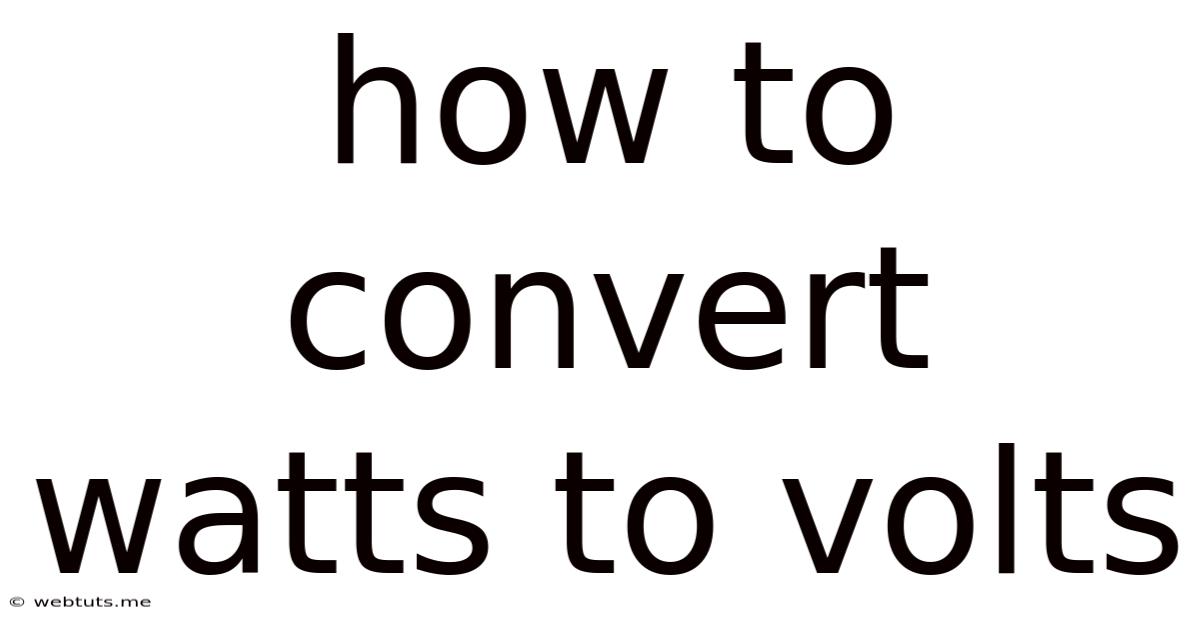How To Convert Watts To Volts
Webtuts
May 12, 2025 · 4 min read

Table of Contents
How to Convert Watts to Volts: A Comprehensive Guide
Understanding the relationship between watts and volts is crucial for anyone working with electricity. While they're both fundamental units of measurement, they represent different aspects of electrical power. Watts (W) measure power, the rate at which energy is used, while volts (V) measure electrical potential, the "push" that drives electrons through a circuit. You can't directly convert watts to volts without knowing a third factor: current (amperes or amps, A). This article will delve into the intricacies of this relationship, explaining the underlying principles and providing practical examples to enhance your understanding.
Understanding the Fundamentals: Watts, Volts, and Amps
Before we explore the conversion process, let's solidify our understanding of each unit:
-
Volts (V): Voltage represents the electrical potential difference between two points in a circuit. Think of it as the "pressure" that pushes electrons through the circuit. A higher voltage means a greater push, resulting in a potentially stronger current.
-
Amps (A): Amperes, or amps, measure the rate of electron flow, or electric current. It represents the quantity of electrons passing a given point in a circuit per unit of time. A higher amperage indicates a greater flow of electrons.
-
Watts (W): Watts measure electrical power, representing the rate at which electrical energy is consumed or produced. It's the product of voltage and current.
The Power Formula: The Key to Conversion
The relationship between watts, volts, and amps is defined by a fundamental formula in electrical engineering:
Power (Watts) = Voltage (Volts) x Current (Amps)
Or, more concisely:
P = V x I
This formula is the cornerstone for converting watts to volts (or vice-versa). To find the voltage, you need to rearrange the formula:
V = P / I
Step-by-Step Conversion: Practical Examples
Let's illustrate the conversion process with some practical examples. Remember, you must know the current (amps) to convert watts to volts.
Example 1: A Simple Circuit
Suppose you have a light bulb that consumes 60 watts of power and draws a current of 0.5 amps. What is its voltage?
-
Identify the known values:
- Power (P) = 60 Watts
- Current (I) = 0.5 Amps
-
Apply the formula:
- V = P / I
- V = 60 Watts / 0.5 Amps
- V = 120 Volts
Therefore, the light bulb operates at 120 volts.
Example 2: A Higher Power Device
Let's consider a more powerful appliance, such as a 1500-watt microwave oven drawing 12.5 amps. What's its voltage?
-
Identify the known values:
- Power (P) = 1500 Watts
- Current (I) = 12.5 Amps
-
Apply the formula:
- V = P / I
- V = 1500 Watts / 12.5 Amps
- V = 120 Volts
This microwave also operates on a standard 120-volt supply.
Example 3: Dealing with Milliamps
Sometimes, current is expressed in milliamps (mA), which is one-thousandth of an amp. Remember to convert milliamps to amps before applying the formula.
Let's say a small electronic device uses 5 watts of power and draws 250 mA. What's its voltage?
-
Convert milliamps to amps:
- 250 mA = 250 / 1000 Amps = 0.25 Amps
-
Identify the known values:
- Power (P) = 5 Watts
- Current (I) = 0.25 Amps
-
Apply the formula:
- V = P / I
- V = 5 Watts / 0.25 Amps
- V = 20 Volts
This device operates at 20 volts.
Beyond the Basics: Understanding Power Consumption
The relationship between watts, volts, and amps is vital for understanding how much power different devices consume. This knowledge is essential for:
-
Selecting appropriate power supplies: Ensuring your power supply can handle the wattage and voltage requirements of your devices is crucial to avoid damage.
-
Optimizing energy usage: Understanding power consumption allows you to make informed decisions about energy-efficient appliances and practices.
-
Troubleshooting electrical problems: Incorrect voltage or amperage can lead to malfunctions; knowing these values helps diagnose the problem.
Practical Applications and Considerations
The ability to convert watts to volts is invaluable in various applications:
-
Electronics repair: Troubleshooting faulty circuits often involves calculating voltage based on known wattage and current.
-
Electrical design: Designing electrical systems requires accurate calculations of voltage, current, and power to ensure safety and efficiency.
-
Renewable energy systems: Calculating the power output of solar panels or wind turbines involves understanding the relationship between watts and volts.
Important Safety Precautions
Working with electricity can be dangerous. Always follow these safety precautions:
-
Turn off the power: Before working with any electrical circuit, always disconnect it from the power source.
-
Use appropriate tools: Employ insulated tools to prevent electrical shock.
-
Seek professional help: If you're unsure about any aspect of electrical work, consult a qualified electrician.
Conclusion
Converting watts to volts requires understanding the fundamental relationship between power, voltage, and current. The formula P = V x I is the key to performing this conversion. Remember, you always need to know the current (in amps) to determine the voltage. By understanding these concepts and applying the formula correctly, you can effectively manage and understand electrical systems and devices. Remember always to prioritize safety when working with electricity.
Latest Posts
Related Post
Thank you for visiting our website which covers about How To Convert Watts To Volts . We hope the information provided has been useful to you. Feel free to contact us if you have any questions or need further assistance. See you next time and don't miss to bookmark.